Want To Get Into Running? Here’s A Checklist Of Everything You Need
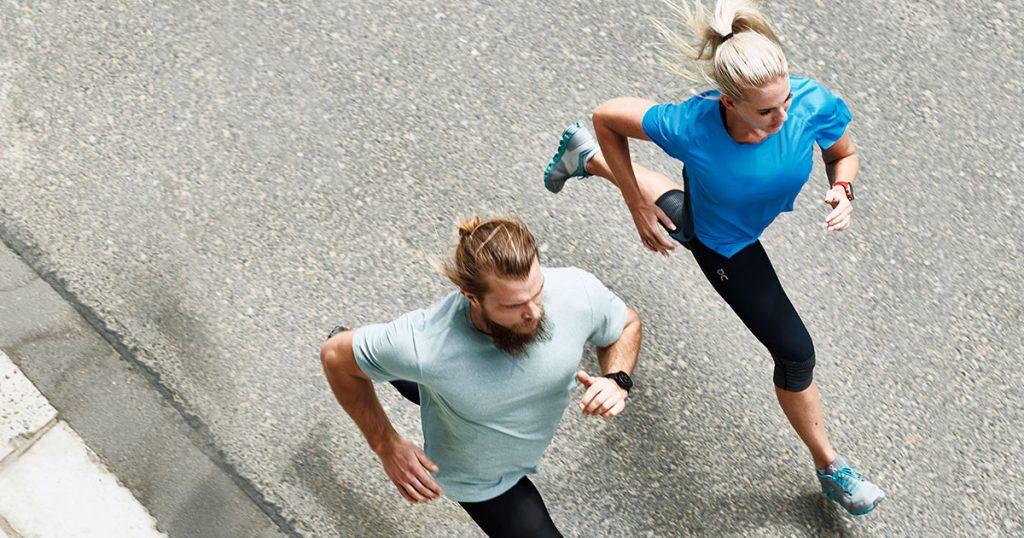
Want To Get Into Running? Here’s A Checklist Of Everything You Need Woman running alongside her best friend. Starting a running routine can be a great way to improve your physical and mental health. Before you hit the pavement, it’s important to make sure you have everything you need to stay safe and comfortable during your workouts. Here is a checklist of items to consider when starting your running routine: Running shoes: Investing in a good pair of running shoes is essential to prevent injury and provide the proper support for your feet. Look for shoes that are comfortable, have good arch support, and are designed for running. Comfortable clothing: Wearing comfortable, moisture-wicking clothing can help you stay cool and dry during your workouts. Look for clothes made from breathable fabrics, such as cotton or polyester, and avoid clothing that is too tight or restrictive. Socks: Socks are often overlooked, but they play an important role in keeping your feet comfortable and preventing blisters. Look for socks made from moisture-wicking materials and avoid cotton socks, which can retain moisture and lead to blisters. Water bottle: Staying hydrated is crucial when running, especially during hot weather. Bring a water bottle with you on your runs and make sure to drink water before, during, and after your workouts. Sunscreen: Protecting your skin from the sun’s harmful rays is important, even on cloudy days. Apply sunscreen with at least SPF 30 to exposed skin before heading out for your run. Hat or sunglasses: Wearing a hat or sunglasses can help protect your face and eyes from the sun’s rays and prevent squinting, which can cause headaches. Reflective gear: If you plan to run in low-light conditions, such as at dawn or dusk, it’s important to wear reflective gear to increase your visibility to drivers and cyclists. Phone or GPS watch: Using a phone or GPS watch can help you track your distance, pace, and progress during your runs. It can also be a safety tool in case of an emergency. ID bracelet or card: Carrying an ID bracelet or card with your name, emergency contact information, and any medical conditions can be helpful in case of an emergency. Music or podcasts: Listening to music or podcasts can make your runs more enjoyable and help you stay motivated. Consider creating a playlist of your favorite songs or finding a podcast that interests you. By following this checklist, you can ensure that you have everything you need to start your running routine on the right foot. Remember to start slow and gradually increase your distance and intensity to prevent injury and enjoy the benefits of running for years to come.
15 Exercises You Can Do At Home With No Equipment
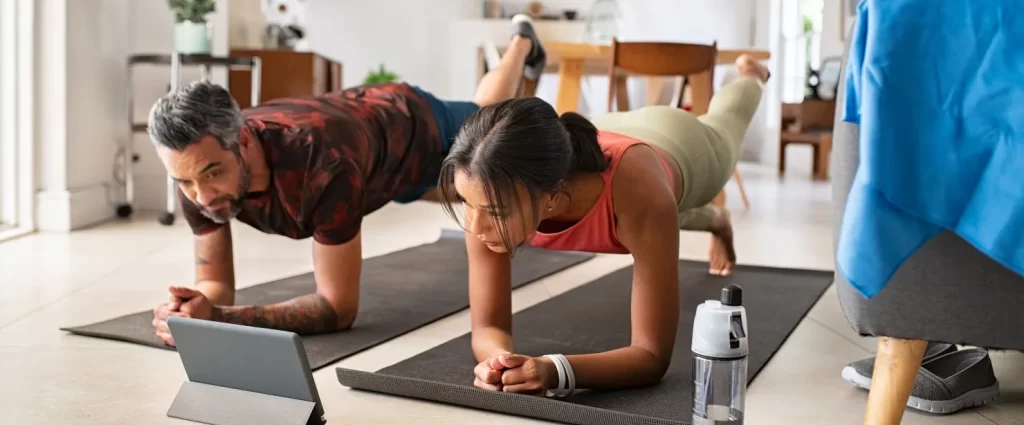
15 Exercises You Can Do At Home With No Equipment Daughter and father exercising. Exercising at home with no equipment is an excellent way to stay active and improve your health and fitness. You don’t need expensive gym memberships or fancy equipment to get a great workout. Here are 15 exercises you can do at home with no equipment: Push-ups – Push-ups are a classic bodyweight exercise that work your chest, triceps, and shoulders. Start with a few sets of 10-15 reps and work your way up to more challenging variations. Squats – Squats are a great lower body exercise that work your glutes, quads, and hamstrings. Stand with your feet shoulder-width apart, bend your knees, and lower your hips towards the ground. Keep your chest up and your weight in your heels. Lunges – Lunges are another great lower body exercise that work your glutes, quads, and hamstrings. Step forward with one foot and bend your knee until your thigh is parallel to the ground. Repeat on the other side. Plank – Planks are an excellent core exercise that work your abs, lower back, and hips. Hold a straight-arm plank for 30-60 seconds, keeping your body in a straight line from head to heels. Mountain climbers – Mountain climbers are a dynamic exercise that work your core, shoulders, and legs. Start in a push-up position and bring one knee towards your chest. Switch legs quickly and repeat. Burpees – Burpees are a full-body exercise that work your legs, core, and upper body. Start in a standing position, drop into a squat, kick your feet back into a push-up position, do a push-up, jump your feet back to your hands, and jump up explosively. Jumping jacks – Jumping jacks are a great way to get your heart rate up and work your legs and shoulders. Start with your feet together and arms at your sides. Jump your feet out and raise your arms overhead. Jump back to the starting position. High knees – High knees are a cardio exercise that work your legs and core. Run in place and bring your knees up to hip height. Butt kicks – Butt kicks are another cardio exercise that work your legs and core. Run in place and kick your heels towards your butt. Tricep dips – Tricep dips work the backs of your arms. Sit on the edge of a chair or bench and place your hands behind you. Lower your hips towards the ground and push back up. Wall sits – Wall sits are a great lower body exercise that work your quads and glutes. Lean against a wall and lower your body until your thighs are parallel to the ground. Bicycle crunches – Bicycle crunches work your abs and obliques. Lie on your back and bring your knees towards your chest. Alternate bringing your left elbow to your right knee and your right elbow to your left knee. Superman – Superman is a great exercise for your lower back. Lie on your stomach and lift your arms and legs off the ground. Calf raises – Calf raises work your calf muscles. Stand with your feet shoulder-width apart and raise your heels off the ground. Lower back down. Side planks – Side planks work your obliques and core. Lie on your side and prop yourself up on your elbow. Raise your hips off the ground and hold. In conclusion, there are many exercises you can do at home with no equipment. By incorporating a few of these exercises into your daily routine, you can improve your fitness, strength, and overall health.
9 Non-dairy Foods That Are High In Calcium
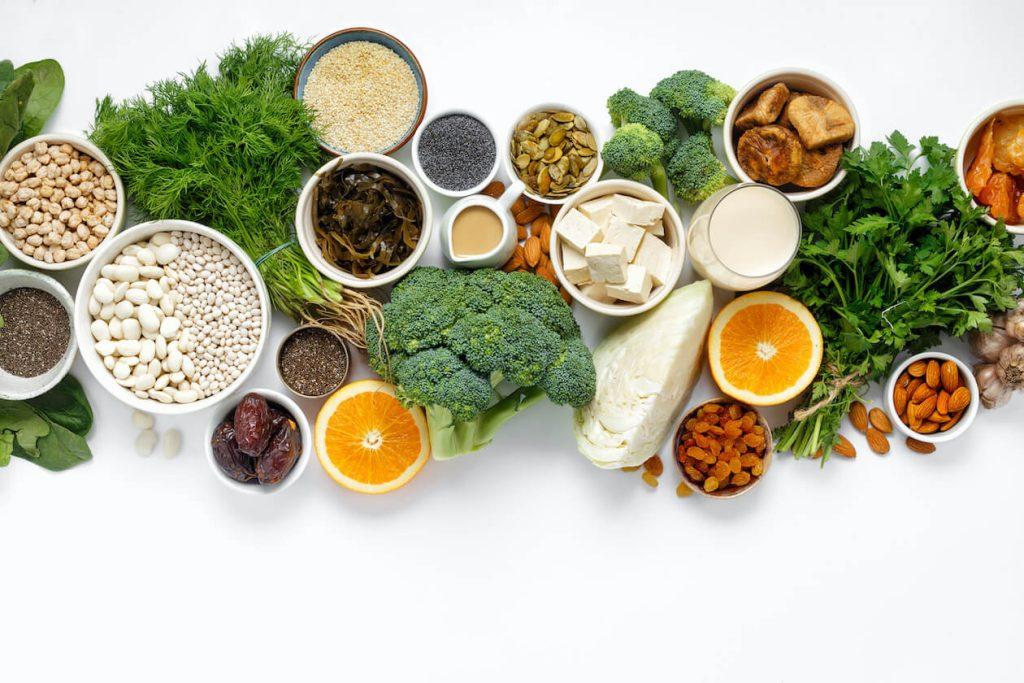
9 Non-Diary Foods That Are High In Calcium Foods high in calcium. Calcium is an essential nutrient that plays a crucial role in maintaining healthy bones and teeth, as well as supporting other bodily functions like nerve transmission and muscle contraction. While dairy products are a common source of calcium, there are many non-dairy foods that are high in calcium as well. Here are nine non-dairy foods that are high in calcium: Leafy Greens – Leafy greens like kale, collard greens, and spinach are rich in calcium, with around 100-250 milligrams of calcium per cup of cooked greens. These greens are also high in other important nutrients like vitamin K and iron. Tofu – Tofu is a versatile soy-based food that is high in calcium, with around 434 milligrams of calcium per half-cup of firm tofu. It is also a good source of protein and other nutrients. Canned fish – Canned fish like salmon and sardines are a good source of calcium, with around 180-210 milligrams of calcium per 3-ounce serving. They are also a good source of omega-3 fatty acids and other nutrients. Almonds – Almonds are a type of nut that are high in calcium, with around 76 milligrams of calcium per ounce. They are also a good source of healthy fats and other nutrients. Fortified Foods – Many foods are fortified with calcium, including some types of plant-based milk, orange juice, and cereal. These foods can be a convenient way to get more calcium in your diet, with around 200-300 milligrams of calcium per serving. Chia seeds – Chia seeds are a type of seed that are high in calcium, with around 179 milligrams of calcium per ounce. They are also a good source of fiber and other nutrients. Beans – Beans like navy beans, black beans, and pinto beans are a good source of calcium, with around 90-115 milligrams of calcium per half-cup serving. They are also a good source of protein and other nutrients. Broccoli – Broccoli is a type of vegetable that is high in calcium, with around 43 milligrams of calcium per half-cup serving. It is also a good source of other important nutrients like vitamin C and fiber. Sesame seeds – Sesame seeds are a type of seed that are high in calcium, with around 280 milligrams of calcium per ounce. They are also a good source of healthy fats and other nutrients. In conclusion, while dairy products are a common source of calcium, there are many non-dairy foods that are high in calcium as well. By incorporating some of these foods into your diet, you can boost your calcium intake and enjoy a variety of nutritious foods.
10 Surprising Sources Of Protein
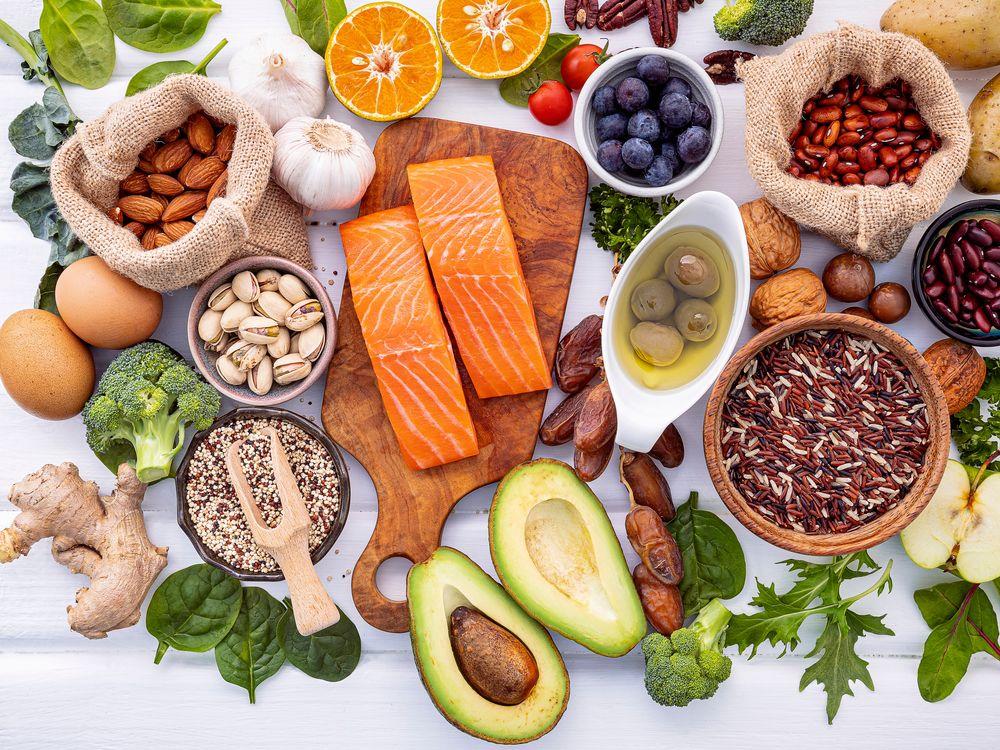
10 Surprising Sources Of Protein High foods in protein scattered on a table Protein is an essential nutrient that plays a crucial role in building and repairing tissues, as well as maintaining overall health. While many people rely on animal-based protein sources like meat, poultry, and fish, there are many surprising sources of protein that you may not have considered. Here are 10 surprising sources of protein: Lentils – Lentils are a type of legume that are high in protein, with around 18 grams of protein per cooked cup. They are also a good source of fiber, iron, and other nutrients. Edamame – Edamame are immature soybeans that are typically served steamed or boiled. They are a great source of plant-based protein, with around 17 grams of protein per cup. Quinoa – Quinoa is a versatile grain that is gluten-free and high in protein, with around 8 grams of protein per cooked cup. It is also a good source of fiber, iron, and other nutrients. Cottage cheese – Cottage cheese is a type of cheese that is low in fat and high in protein, with around 28 grams of protein per cup. It is also a good source of calcium and other nutrients. Greek yogurt – Greek yogurt is a thicker, creamier version of regular yogurt that is high in protein, with around 23 grams of protein per cup. It is also a good source of calcium and other nutrients. Hemp seeds – Hemp seeds are a type of seed that are high in protein and healthy fats, with around 10 grams of protein per 3 tablespoons. They are also a good source of fiber and other nutrients. Seitan – Seitan is a meat substitute made from wheat gluten that is high in protein, with around 25 grams of protein per 3.5 ounces. It is also a good source of iron and other nutrients. Peanut butter – Peanut butter is a popular spread that is high in protein, with around 8 grams of protein per 2 tablespoons. It is also a good source of healthy fats and other nutrients. Spirulina – Spirulina is a type of blue-green algae that is high in protein, with around 4 grams of protein per tablespoon. It is also a good source of other nutrients like iron, calcium, and vitamins. Pumpkin seeds – Pumpkin seeds are a type of seed that are high in protein and healthy fats, with around 5 grams of protein per ounce. They are also a good source of fiber, iron, and other nutrients. In conclusion, while animal-based protein sources are often the go-to for many people, there are many surprising sources of protein available. By incorporating some of these plant-based sources into your diet, you can boost your protein intake and enjoy a variety of nutritious foods.
How Much Protein Do You Actually Need
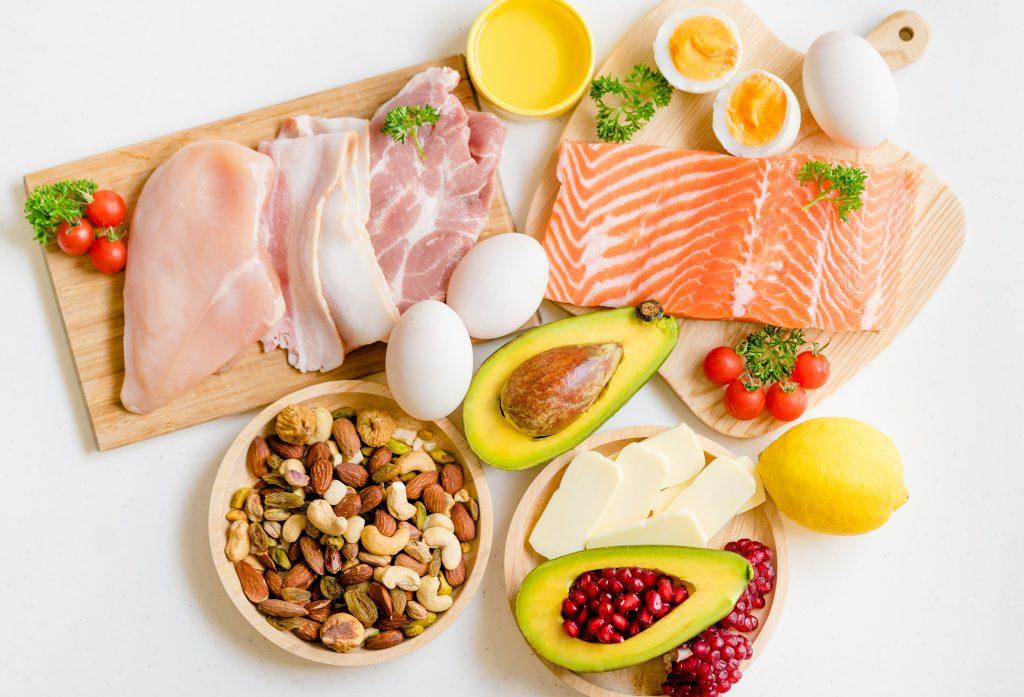
How Much Protein Do You Actually Need Delicious foods that contain protein It’s an age-old question: how much protein do you need for maintaining good health or just building muscle? The answer to this question still varies and continues to be confusing to this day. Having protein in our bodies is a very important part of keeping healthy and alive, along with fats and carbohydrates. To eat enough protein at least every day should be thought about frequently, but how much of it do we need in our bodies? To understand this question people must know what the function of protein is in our lives, the intake of it in our systems, and why we need enough of it. To understand how much protein people need, one must understand the function of protein in the human body. Protein is a nutrient that is found throughout the body; in the muscle-bound, skin, hair, tissues, etc. It plays an important role in the creation and maintenance of the cells in the human body. Fueling our cells and powering our bodies, we need protein in our everyday meals. There are many reasons as to why we need protein in our lives. For example, protein is required for the prolongation and development of the tissues in our bodies. Our bodies protein needs are dependent on our health and activity level. They also fight infections because it Strengthen the immune system and is essential for maintaining body functions such as circulation. Moreover, knowing why we need protein in our lives gives a clearer understanding of how much of it we should be digesting each day. People must understand the daily intake of protein to understand how much or too little of it were consuming. When it comes to protein, everyone requires a different amount based on factors such as the weight, physical activity, muscles mass and more. Ideally 10 to 30% of your total calories should come from protein, whereas 45-65% from carbs, and 25-35% from fats. Consuming at least 10-30% of your daily calories from protein should provide your body enough amino acids to keep the body functioning well (livestrong.com). According to The Mayo Health Clinic, the recommended dietary allowance of protein for a somewhat inactive adult is about .8 grams. For example, a person who weighs 150 pounds should consume about 55 grams of protein per day. Furthermore, as you continue to age and become more inactive, to maintain quality of life, one should increase their protein intake by about 1-1.2 grams. To meet dietary protein needs people should spread out protein consumption evenly throughout each day. People can also choose from the healthiest protein sources to eat out of which includes; nuts,beans,lentils, eggs, chickens, and varieties of fishes. Overall, proteins are macronutrients that are vital to the function of the human body on almost every level. It’s important for tissue growth and repair, hormone production, and a healthy immune system. Protein can be found in many foods, and a balanced diet can provide all necessary amino acids (molecules that combine to form proteins) for our bodies. The amount of protein we take should be around .8 grams and for people who exercise regularly it should increase by about 1.1-1.5 grams per kg. To meet any of these needs people must also make sure they should have these proteins during every meal of the day for breakfast, lunch, and dinner. It is therefore good to consume lots of proteins.
Ways To Ensure Healthy Living

Ways To Ensure Healthy Living 3 Best Friends Taking Pictures In Summer Many of us want a healthy lifestyle but don’t know how to achieve that. Being healthy is fairly easy but having a healthy lifestyle is another issue. What’s the difference you might ask? Well- being healthy is not just about being fit and rid of diseases it’s also about being happy on the inside and out. The World Health Organization (WHO) says “Health is a state of complete physical, mental, and social well-being and not merely the absence of disease or infirmity.” Having a healthy lifestyle consists of mental/emotional well-being, physical, spiritual, and social. You have to be well acquainted with each of these to truly be healthy. Starting with the most common and easiest of these—physical health. Physical health consists of eating healthy, minimized risk of injury, prevention of disease, and exercise. Eating healthy and exercise have a lot of misconceptions to it; one of them being that you can’t have junk food, whereas you can have it but in moderation. Food should be enjoyed and knowing how to control your cravings is the trick to true healthy eating. Another one is if you exercise you can eat whatever you want, no you can’t. just because you work out for an hour doesn’t mean you can go back and regain all the calories you lost. A huge misconception is that you have to be skinny to be healthy which isn’t true; as long as you are healthy by health standards then it doesn’t matter if you weigh a little more than you have to. To get on track with your physical health try to eat three meals a day; listen to your body when you’re hungry or thirsty. Many people don’t know where to start when it comes to exercising—should I just focus on one part of my body or everything? To be clear you can’t target one part of your body because you will lose weight everywhere but if you target that area, you will see a larger change in that area than the others. A good starter for an exercise routine is doing high-intensity cardio on Mondays, upper body strength(arms/abs) on Tuesdays, Wednesdays are lower body strength and abs, Thursday is stretch and recovery, Fridays light exercise, no jumping cardio on Saturdays, and rest on Sundays. You can alter your routine to target whatever part of your body. Though physical health is the most common mental health is the most talked about. Having a steady and healthy mind is essential for a healthy lifestyle. Mental health is your way of thinking—positive or negative. It is how you handle stress and different issues and your course of action. Mental health is taught in schools but never truly practiced. Students go home after learning what to do to fix their mental health then get hit with a bunch of homework and start stressing about it and other things which can cause anxiety and in worst cases, depression. Most people would tell you to be more optimistic about things, but it is not that easy. Being happy and ready to do anything every day is extremely difficult. To succeed in mental health, you need to stay active, talk to someone, don’t skip sleep, relax often but work hard, and be social. By staying active more blood circulates to the brain and more oxygen and nutrients. Your brain releases serotonin, dopamine and other hormones when you exercise because you have achieved something and feel refreshed after. mental health includes talking if not therapists would be useless. When you bottle up emotions you become stressed and put an emotional strain on your brain making you feel depressed. Sleeping the required hours your body needs is important so it can store new information and rid toxic waste. The body repairs itself and stores energy while you sleep, so get your beauty rest! In my list of goals, I tell myself to make at least one new friend every two months. Having friends can save you from so much stress in your life. Good friends will make you feel like you have someone to support you and have your back at all times. Some people are more social than others, but we all need some sort of support. To get a friend you need to be a friend listen to others and don’t be self-centered. Be respectful of ideas. To make friends introduce yourself to others and see what you have in common, taking about what you have in common will be the seed you need to see the friendship bloom. Research says that being lonely increases depression, anxiety, low self-esteem, and problems sleeping. So, find yourself some friends but get rid of toxic people in your life. People who are toxic and self-centered are not real friends they will bring you down more than being lonely. You need to be able to identify which people will be good for your health, keep them and grow your relationship. Then build up other aspects of your life. You wont be able to achieve all of this at once so take it slow. Start with your physical health and make a habit of exercising everyday and when you have that mastered start working on mental health. Find times to meditate, find what keeps you grounded and your happy place. Go out more and socialize, meet new people and bond.
How To Get Started With Healthy Meal Prep

How To Get Started With A Healthy Meal Prep Man picking up veggies from local store . Healthy meal prep is a great way to take control of your diet and ensure that you’re eating nutritious and delicious food throughout the week. It can be intimidating to get started, but with some planning and preparation, anyone can become a meal prep pro! Here are some tips to help you get started with healthy meal prep: 1. Plan your meals The first step in meal prep is to plan out your meals for the week. Start by thinking about your schedule and what you’ll be doing each day. This will help you determine how many meals you need to prepare and when you’ll have time to do so. Then, make a list of healthy recipes and snacks that you want to make, and gather any necessary ingredients. 2. Batch cook One of the keys to successful meal prep is to batch cook. This means making a large quantity of a particular dish that can be portioned out and eaten throughout the week. For example, you could cook a big batch of quinoa, roasted vegetables, or grilled chicken. Having pre-cooked components on hand will make it easy to throw together a healthy meal in a pinch. 3. Use meal prep containers Invest in some good quality meal prep containers to store your food in. Glass containers are a great option because they can be reheated in the microwave or oven without any negative effects. Mason jars are also useful for storing salads and snacks. 4. Mix and match Don’t be afraid to mix and match your meal prep components throughout the week. For example, you could use your pre-cooked quinoa in a salad one day and in a stir-fry the next. This will help keep your meals interesting and prevent boredom. 5. Prep in advance Try to do as much prep work as possible in advance. This includes washing and chopping vegetables, cooking grains and proteins, and making sauces and dressings. Doing this prep work on the weekend will save you time and stress during the week. 6. Be mindful of portion sizes When meal prepping, it’s important to be mindful of portion sizes. Use a food scale or measuring cups to ensure that you’re eating the right amount of each component. This will help you avoid overeating and ensure that you’re getting the proper balance of macronutrients. 7. Don’t forget snacks Healthy snacks are an important part of any meal prep routine. Prepare snacks like sliced veggies, hard-boiled eggs, hummus, or nuts to have on hand when hunger strikes. In conclusion, healthy meal prep can be a fun and rewarding way to take control of your diet and ensure that you’re eating nutritious and delicious food throughout the week. With some planning and preparation, anyone can become a meal prep pro!
10 Healthy Recipes That Feel Indulgent
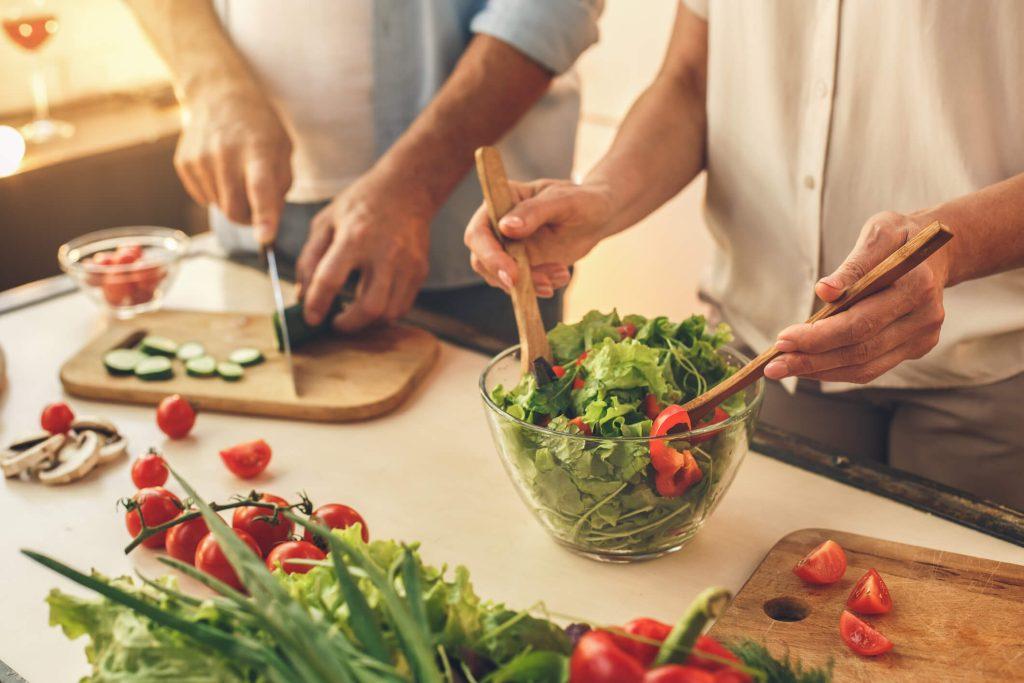
10 Healthy Recipes That Feel Indulgent Two people helping out to prepare a salad. Eating healthy doesn’t mean you have to give up on flavor or feeling satisfied. With the right ingredients and a little creativity, you can prepare healthy dishes that taste indulgent and are also good for you. Here are 10 mouth-watering recipes that will satisfy your cravings without sacrificing your health. 1. Baked Sweet Potato Fries Instead of reaching for the deep-fried potato chips, try making baked sweet potato fries. They are a great source of vitamin A, fiber, and complex carbohydrates. Cut sweet potatoes into thin strips, toss them in a little olive oil, sprinkle with salt and pepper, and bake in the oven until crispy. 2. Grilled Chicken with Mango Salsa Grilled chicken is a great source of protein and paired with sweet and spicy mango salsa, it makes for a deliciously satisfying meal. Marinate chicken breasts in a mixture of olive oil, lime juice, garlic, and spices, then grill until cooked through. Serve with mango salsa made with chopped mango, red onion, cilantro, and jalapeno. 3. Quinoa and Black Bean Salad This colorful and flavorful salad is a great source of plant-based protein, fiber, and essential vitamins and minerals. Cook quinoa according to package instructions and mix with black beans, red bell pepper, corn, and avocado. Dress with a lime and cumin vinaigrette for added flavor. 4. Healthy Eggplant Parmesan This classic Italian dish gets a healthy twist by swapping out the traditional breaded and fried eggplant for a lighter baked version. Slice eggplant into rounds, brush with olive oil, and bake until tender. Top with tomato sauce, mozzarella cheese, and fresh basil and bake until the cheese is melted and bubbly. 5. Greek Yogurt and Berry Parfait For a healthy and indulgent breakfast or dessert, try a Greek yogurt and berry parfait. Layer Greek yogurt with fresh berries, honey, and granola for added crunch. Greek yogurt is a great source of protein and calcium, while berries are high in antioxidants and fiber. 6. Cauliflower Crust Pizza If you’re looking for a healthier pizza option, try making a cauliflower crust pizza. Blend cauliflower florets in a food processor until they resemble rice, then mix with egg, cheese, and herbs. Bake in the oven until crispy, then top with your favorite pizza toppings. 7. Lentil Soup Lentil soup is a comforting and hearty meal that is also packed with protein, fiber, and essential vitamins and minerals. Cook lentils with diced vegetables, herbs, and spices for added flavor. Serve with crusty bread for a satisfying and healthy meal. 8. Broiled Salmon with Lemon and Dill Salmon is a great source of heart-healthy omega-3 fatty acids and paired with lemon and dill, it makes for a fresh and flavorful meal. Place salmon fillets on a baking sheet, brush with olive oil and lemon juice, and sprinkle with fresh dill. Broil in the oven until cooked through. 9. Healthy Chocolate Smoothie For a healthy and indulgent treat, try a chocolate smoothie made with almond milk, frozen banana, cocoa powder, and a scoop of protein powder. Blend until smooth and creamy for a satisfying and nutrient-packed snack. 10. Roasted Brussels Sprouts Roasted Brussels sprouts are a tasty and healthy side dish that is also easy to prepare. Cut Brussels sprouts in half, toss with olive oil, salt, and pepper, and roast in the oven until crispy and tender. Serve alongside grilled chicken or fish for a well-rounded meal. In Conclusion Eating healthy doesn’t have to mean sacrificing flavor or feeling satisfied. With these 10 delicious foods.
How Fast Can I Lose Weight ?

How Fast Can I Lose Weight ? Shot of a young man preparing a meal at his food stall. Losing weight is a common goal for many people. However, the speed at which you can lose weight depends on several factors, including your starting weight, body composition, activity level, and calorie intake. In general, losing weight too quickly can be unsafe and unsustainable. Here is a breakdown of how fast you can lose weight while staying healthy. Safe Weight Loss Rate A safe rate of weight loss is about 0.5 to 2 pounds per week, which equates to 2 to 8 pounds per month. Losing weight at this rate is sustainable and helps you avoid losing muscle mass. Losing more than 2 pounds per week may result in muscle loss and can be harmful to your health. Caloric Deficit To lose weight, you need to create a caloric deficit. This means you need to burn more calories than you consume. A pound of fat is equivalent to 3,500 calories. Therefore, to lose one pound per week, you need to create a deficit of 500 calories per day. You can do this by reducing your calorie intake, increasing your physical activity, or a combination of both. Starting Weight The amount of weight you have to lose affects how quickly you can lose weight. People who have more weight to lose may lose weight faster than those who have less weight to lose. This is because people with more weight to lose tend to have a higher metabolic rate and burn more calories. Body Composition Your body composition also affects how quickly you can lose weight. If you have a higher percentage of muscle mass, you may lose weight faster than someone with a higher percentage of body fat. This is because muscle burns more calories at rest than fat. Activity Level Physical activity plays a crucial role in weight loss. People who are more physically active tend to lose weight faster than those who are sedentary. Exercise not only burns calories but also helps you build muscle, which can speed up your metabolism. Diet Your diet is another essential factor in weight loss. Eating a balanced diet that is low in calories and high in nutrients can help you lose weight faster. Focus on eating whole foods like fruits, vegetables, whole grains, and lean protein sources. Avoid processed foods, sugary drinks, and high-fat foods. Water Intake Drinking enough water is essential for weight loss. Water helps you feel full, which can prevent overeating. It also helps your body flush out toxins and waste products. Aim to drink at least eight glasses of water per day. Sleep Getting enough sleep is crucial for weight loss. Lack of sleep can lead to increased hunger and cravings, which can sabotage your weight loss efforts. Aim to get at least seven to eight hours of sleep per night. In conclusion, the safe and sustainable rate of weight loss is about 0.5 to 2 pounds per week. Losing weight too quickly can be harmful to your health and can result in muscle loss. To lose weight, you need to create a caloric deficit by reducing your calorie intake, increasing your physical activity, or a combination of both. Factors that affect how quickly you can lose weight include your starting weight, body composition, activity level, diet, water intake, and sleep.
How To Lose Weight Without Dieting

How To Lose Weight Without Dieting Man preparing healthy meal. Losing weight can be a daunting task, especially if you don’t want to go on a strict diet. Fortunately, there are many ways to lose weight without depriving yourself of the foods you love. Here are 10 tips for losing weight without dieting: Eat Whole Foods One of the best ways to lose weight without dieting is to focus on whole, nutritious foods. This means eating foods that are as close to their natural state as possible, such as fruits, vegetables, whole grains, lean proteins, and healthy fats. 2. Pay Attention to Portion Sizes Even if you’re eating healthy foods, it’s important to pay attention to portion sizes. Try using a smaller plate or measuring your food to make sure you’re not eating too much. 3. Drink Plenty of Water Drinking plenty of water can help you lose weight by keeping you hydrated and reducing your appetite. Aim for at least eight glasses of water per day. 4. Limit Sugary Drinks Sugary drinks like soda, juice, and sports drinks can be a major source of calories. Try to limit your intake of these drinks and opt for water, unsweetened tea, or sparkling water instead. 5. Get Enough Sleep Getting enough sleep is important for weight loss because it helps regulate hormones that control hunger and metabolism. Aim for at least seven hours of sleep per night. 6. Exercise Regularly Exercise is crucial for weight loss because it helps you burn calories and build muscle. Aim for at least 30 minutes of moderate exercise per day, such as brisk walking, cycling, or swimming. 7. Be Mindful of Your Eating Mindful eating involves paying attention to your food and your body’s signals of hunger and fullness. This can help you avoid overeating and make healthier choices. 8. Reduce Stress Stress can lead to overeating and weight gain. Try to find ways to reduce stress in your life, such as meditation, yoga, or spending time outdoors. 9. Surround Yourself with Supportive People Having supportive friends and family members can help you stay motivated and on track with your weight loss goals. Surround yourself with people who encourage and inspire you. 10. Be Patient and Persistent Losing weight without dieting takes time and effort. Be patient with yourself and celebrate small successes along the way. Keep up with healthy habits even when progress is slow, and eventually, you’ll see results. In conclusion, losing weight without dieting is possible by making small, sustainable changes to your lifestyle. By focusing on whole foods, portion sizes, hydration, sleep, exercise, mindfulness, stress reduction, support, and persistence, you can achieve your weight loss goals without feeling deprived. Remember, it’s about making healthy choices that you can stick with for the long haul. making healthy choices that you can stick with for the long haul.

